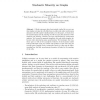367 search results - page 56 / 74 » Amalgamation of cellular automata |
ISVLSI
2003
IEEE
14 years 20 days ago
2003
IEEE
The need for small, high speed, low power computers as the end of Moore’s law approaches is driving research into nanotechnology. These novel devices have significantly differe...
GLVLSI
1999
IEEE
13 years 11 months ago
1999
IEEE
Despite the seemingly endless upwards spiral of modern VLSI technology, many experts are predicting a hard wall for CMOS in about a decade. Given this, researchers continue to loo...
ASPDAC
2005
ACM
13 years 9 months ago
2005
ACM
— Quantum-dot Cellular Automata (QCA) is a novel computing mechanism that can represent binary information based on spatial distribution of electron charge configuration in chem...
ALIFE
2010
13 years 7 months ago
2010
Edgar Codd's 1968 design for a self-replicating cellular automata machine has never been implemented. Partly this is due to its enormous size but we have also identified four...
CORR
2010
Springer
13 years 7 months ago
2010
Springer
Abstract. Cellular automata have been mainly studied for on very regular graphs carrying the cells (like lines or grids) and under synchronous dynamics (all cells update simultaneo...

